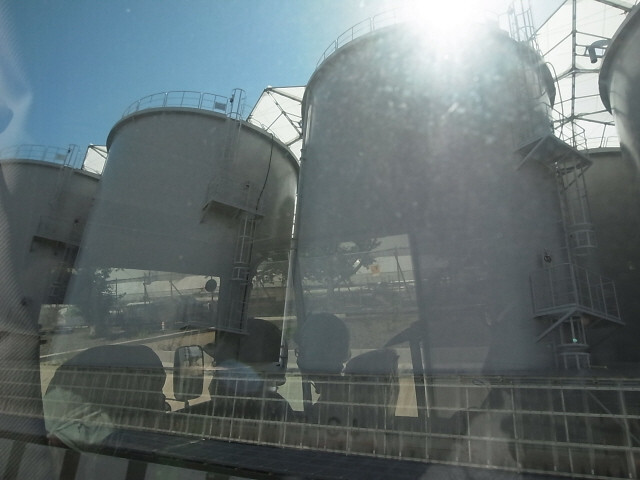hankyoreh
Links to other country sites 다른 나라 사이트 링크
Tokyo Electric Power Company announces plans for ocean dump of water from Fukushima power plant

The South Korean Ministry of Oceans and Fisheries (MOF) responded to the announcement of a Tokyo Electric Power Company (TEPCO) draft plan for the ocean dump of radiation-contaminated water from the Fukushima Daiichi Nuclear Power Plant by reiterating its position that it “cannot support the Japanese government discharging contaminated water from the Fukushima Daiichi Nuclear Power Plant in the sea without discussions with neighboring countries.”
TEPCO announced a draft plan including concrete measures for disposing of around 1.2 million tons of contaminated water currently being stored in water tanks at the Fukushima Daiichi Nuclear Power Plant site, Japanese news outlets reported on Mar. 25. This came as a follow-up measure to a Ministry of Economy, Trade and Industry (METI) subcommittee decision in December of last year naming an ocean dump as the most feasible means of disposing of the contaminated water.
TEPCO draft plan for ocean dump over a period of 10 to 30 yearsThe TEPCO draft plan outlined an approach of using a multi-nuclide removal system known as ALPS for an additional purification of the contaminated water of 62 radioactive substances -- not including tritium, which has similar properties to water -- before releasing it into the ocean over a period of 10 to 30 years. A 2018 examination of 890,000 out of a total of 950,000 tons of Fukushima water that had undergone ALPS purification showed 750,000 tons, or over 80%, to still contain radioactive substances above the threshold for release.
TEPCO shared four scenarios involving the release of tritium at annual rates ranging from 22 to 100 terabecquerels. Under the 100 TBq scenario, which represented the largest annual volume, the ocean dump would be completed within 10 years; under the 22 TBq scenario, it would take 30 years. TEPCO claimed that even if 100 TBq of tritium is released per year, concentrations of radioactive material would only exceed current levels for an area of the ocean stretching for roughly 30km north and south of the Fukushima Nuclear Power Plant. The Japanese government plans to begin hearing feedback from local residents on Apr. 6, beginning in the Fukushima city center.
In response, Song Myeong-dal, a marine environment policy officer for MOF, said, “The Ministry of Foreign Affairs is currently confirming the facts.”
“Fundamentally, the idea of dumping contaminated water from the Fukushima Nuclear Power Plant into the sea has not been tested for safety, and we cannot support it,” Song added.
“Instead of having the Japanese government decide things on its own, neighboring countries such as South Korea and China should be taking part in examining the safety of the disposal plan before a decision is made,” he urged.
By Cho Ki-weon, Tokyo correspondent, and Kim Kyu-won, staff reporter
Please direct comments or questions to [english@hani.co.kr]

Editorial・opinion
![[Column] Season 2 of special prosecutor probe may be coming to Korea soon [Column] Season 2 of special prosecutor probe may be coming to Korea soon](https://flexible.img.hani.co.kr/flexible/normal/500/300/imgdb/original/2024/0426/3317141030699447.jpg) [Column] Season 2 of special prosecutor probe may be coming to Korea soon
[Column] Season 2 of special prosecutor probe may be coming to Korea soon![[Column] Park Geun-hye déjà vu in Yoon Suk-yeol [Column] Park Geun-hye déjà vu in Yoon Suk-yeol](https://flexible.img.hani.co.kr/flexible/normal/500/300/imgdb/original/2024/0424/651713945113788.jpg) [Column] Park Geun-hye déjà vu in Yoon Suk-yeol
[Column] Park Geun-hye déjà vu in Yoon Suk-yeol- [Editorial] New weight of N. Korea’s nuclear threats makes dialogue all the more urgent
- [Guest essay] The real reason Korea’s new right wants to dub Rhee a founding father
- [Column] ‘Choson’: Is it time we start referring to N. Korea in its own terms?
- [Editorial] Japan’s rewriting of history with Korea has gone too far
- [Column] The president’s questionable capacity for dialogue
- [Column] Are chaebol firms just pizza pies for families to divvy up as they please?
- [Column] Has Korea, too, crossed the Rubicon on China?
- [Correspondent’s column] In Japan’s alliance with US, echoes of its past alliances with UK
Most viewed articles
- 1After election rout, Yoon’s left with 3 choices for dealing with the opposition
- 2AI is catching up with humans at a ‘shocking’ rate
- 3Noting shared ‘values,’ Korea hints at passport-free travel with Japan
- 4Why Kim Jong-un is scrapping the term ‘Day of the Sun’ and toning down fanfare for predecessors
- 5Two factors that’ll decide if Korea’s economy keeps on its upward trend
- 6South Korea officially an aged society just 17 years after becoming aging society
- 7Korea’s 1.3% growth in Q1 signals ‘textbook’ return to growth, says government
- 8Is Japan about to snatch control of Line messenger from Korea’s Naver?
- 91 in 5 unwed Korean women want child-free life, study shows
- 10[Reportage] On US campuses, student risk arrest as they call for divestment from Israel